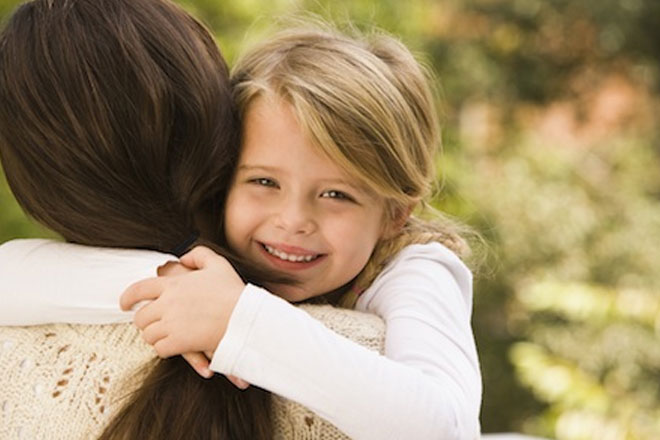Let’s talk about the elephant in the room–physical abuse. It’s something that most parents have a hard time talking about. However, awareness is power. It’s important that we create opportunities to talk to our children about what a good touch is and what is not, like Meeta did.
Meeta and her four-year-old were playing hide-and-seek. Every time Meeta found her daughter, she awarded her with a hug.
During their water-break Meeta asked, “Do you like that?” to her little one and then explained that a hug from mamma is good touch–which is why it feels so good.
Meeta created an opportunity to talk to her child.
Here are five ways in which you can do the same:
1) Avoid the ‘pee-pee’ ‘poo-poo’ talk!
“We don’t live in the Elizabethan age you see!” my son’s paediatrician said when I approached him about the topic I was writing about. What I understood about his unique perspective was that parents don’t give children the credit of being smart enough.
“Kids understand reality if you tell them. Half the time you’re just trying to baby-talk them to understanding the world differently,” he added.
Kids as young as two years of age understand that certain body parts are private. We should tell them the same. Parents can avoid the mushy ‘this is a pee-pee’ talk sometimes and tell them the importance of their body parts.
Your body is your property!
“You need to tell them that their body is their private property amidst the soft talk that you already do,” the doctor explained. He believed that this way, by the time they turn four-to-five, children are aware of each part, their functions, and the fact that it’s private property that they need to safeguard!
“Don’t worry, they won’t get scared!” added the doctor.
2) Talk easy
Well, we just discussed that parents should reduce the mushy talk and sometimes discuss the facts. Now, I’m telling you the opposite. Wondering why?
Talking facts with children and talking as if they are in an official business meeting are two different things. The first is an advice and the latter, they will not understand.
Giving the child looks that say,”Come here, I have a do or die situation that I want to discuss with you,” makes the entire conversation inherently serious.
“Take it easy. Talk causally and initiate the ‘touch-talk’ during playtime or dinner table conversation.” says Dhriti, a Mumbai-based school co-ordinator. I’m sure you agree!
3) What does your undie cover?
“We have an undergarment rule,” says Jitesh.
Over weekends, it’s Jitesh’s duty to brush, bathe, and feed his five-year-old.
“I tell my son that every part that his undergarments cover are those that nobody is allowed to touch. Not even me. This is our undergarment rule,” he adds.
If we know how to go about talking to our children, this point gives us an example of what to actually say.
“My son likes logic and that’s why he likes this rule. Now he knows good touch and bad touch from the perspective of his body parts,” concludes Jitesh.
Could he ask for more?
4) Shout! Shout! Shout!
“We keep telling children to be polite, talk softly, and be well mannered especially around strangers. I teach them to shout!”
This is Dr Upasana, a well-renowned child psychologist who is sitting across the table and enlightening me as how to make my child mannerless!
Seeing the look on my face she laughs and asks me not to worry (worrying should officially be made the synonym for parenting!)
Polite or safe?
Dr Upasana tells me that there is a difference between being polite and being polite amidst strangers who give you odd vibes. When children are given permission to be rude to strangers, they gain confidence.
If kids are rude to someone, they should be encouraged to share the reason why they were impolite, but should not be abruptly stopped.
“I listen to my son and accept his reason, if he has one. I respect his gut feeling,” adds Dr Upasana.
Her son is not scared of making a hue and cry around someone who he seems uncomfortable with. He understands that he has the permission for rudeness when someone is not treating him right.
“Letting them off the ‘good manners‘ hook makes demonstrating this discomfort easy,” concludes the child psychologist.
5) Touching is a thing of the past
Uncle Sameer is visiting and Nina says namaste from a distance. Granny Laxmi says, “Touch your uncle’s feet Nina. Give him a hug!” Nina looks at her mom and then sits next to her granny, whispers, “No naani, it’s not necessary. Mamma said.”
“Don’t force children to hug or touch feet. Not doing that does not make them rude. It just avoids unnecessary touch,” explains Nina’s mom.
Nina and her daughter have made certain rules together. Nina believes that she is a ‘cool’ girl at six and flying kisses or sitting on anyone’s lap is ‘uncool.’ She should carry her ‘cool’ body around with confidence and tell mamma whatever she feels.
Hats off to Nina’s mom for adding the ‘cool’ quotient to the very serious topic of good touch bad touch.
Now I know how and what to tell my son. Do you?














Thank you so much for writing it so clearly. It will help both of us raise our 4 yr old better.